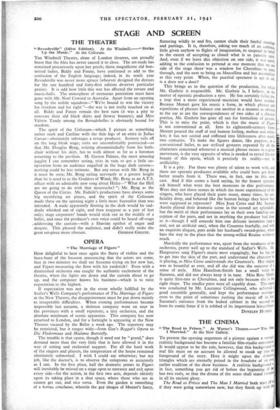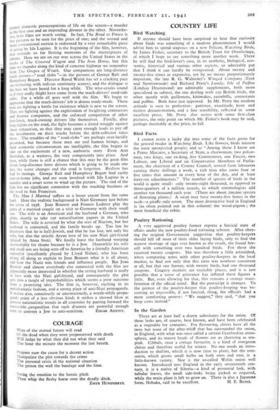THE CINEMA
44 The Road to Frisco." At Warner's Theatre.--“ The Min I Married." At the New Gallery.
To present the opening sequences of a picture against a strong'? realistic background has become a fainiliar film-studio convention It would appear to be the rule, however, that this background of real life must on no account be allowed to sneak up into the foreground of the story. Here it might upset the dome triangles which are eternally poised in the boudoirs of an eve° earlier tradition of the show business. A realistic background in fact, something you get rid of before the beginning of last two reels, so that the drama of the sexes shall stand revew in all its ancient glory., The Road to Frisco and The Man I Married both start off0 if they were going somewhere new, but they finish up With it normal domestic preoccupations of life on the screen—a murder in the first case and an impending divorce in the other. Neverthe- less, both films are worth seeing. In fact, The Road to Frisco is • o pictures to be seen for the price of one; and the second and more conventional section is redeemed by a very remarkable piece of acting by Ida Lupino. It is the beginning of the film, however, that reminds us for fleeting moments of the masterpieces of cinema. Here we are on our way across the United States in the tracks of The Covered Wagon and The Iron Horse, but this time we thunder along the kind of concrete highway we remember from The Grapes of Wrath. Our companions are long-distance truck drivers—" road slobs "—in the persons of George Raft and Humphrey Bogart. Director Raoul Walsh has set a cracking pace (no bothering with tedious continuity scenes), and the dialogue is the best we have heard for a long while. The wise-cracks sound as if they really might have come from the truck-drivers' road-side cafés. For a while all goes well with the film. We begin to appreciate that the truck-drivers' job is drama ready-made. These men are fighting a battle for existence which is new to the screen. They are fighting against the exploitation of freighting contractors and finance companies, and the enforced competition of other free-lance, truck-owning drivers like themselves. Finally, after long nights on the road, the fight becomes a dazed struggle against sheer exhaustion, so that they may carry enough loads to pay off the instalments on their trucks before the debt-collector takes them. The troubles of the " road-slobs " are perhaps over-luridly presented, but because these men are real human beings, and their economic circumstances are intelligible, the film begins to take on the excitement of a new, authentic story. Even Ann Sheridan, as a waitress, fits very competently into place. And then, while there is still a chance that this may be the great film about long-distance lorry drivers which is going to be made one day, the scene changes and the road is forgotten. Realism has had its innings. George Raft and Humphrey Bogart find cushy stay-at-home jobs, and are soon involved with Ida Lupino in a murder and a court scene to wind up the picture. The end of the film has no significant connexion with the trucking business or the road to San Francisco.
The Man I Married suffers to a lesser extent from the same fault. Here the realistic background is Nazi Germany just before the crisis of 1938. Joan Bennett and Francis Lederer play the parts of a married couple on a visit to Germany with their small son. The wife is an American and the husband a German, who plans shortly to take out naturalisation papers in the United States. The wife is revolted by what she sees of Nazism, but her husband is converted, and the family breaks up. Too late he discovers that he is half-Jewish, and that he has lost, not only his wife, but also the strictly Aryan love of his new Nazi girl-friend (played by Anna Sten). We finally leave the husband weeping inconsolably for shame because he is a Jew. Meanwhile his wife and small son are being seen off to America by a friendly American journalist (excellently played by Lloyd Nolan), who has been trying all along to explain to Joan Bennett what it is all about, and how the Nazis win friends and influence people. But Joan Bennett and almost everybody else connected with the film are apparently more interested in whether the erring husband is really in love with the Nazi girl-friend, and consequently the plot gets into a tangle of improbabilities which seems a poor outcome from a promising idea. The film is, however, exciting in its melodramatic fashion, and a strong piece of anti-Nazi propaganda. It makes also, consciously or unconsciously, a worth-while propa- ganda point of a less obvious kind; it strikes a shrewd blow at present nationalistic trends in all countries by putting forward the reasonable ,proposition that such diseases are powerful enough even to convert a Jew to anti-semitism. EDGAR ANSTEY.































 Previous page
Previous page